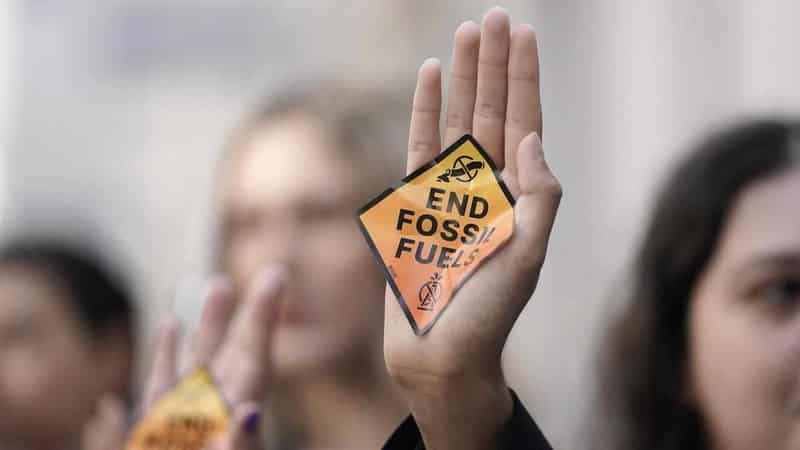
It's crunch time for big polluters as significant investors start making decisions about dumping companies that are failing to clean themselves up.
Insurers, superannuation funds and other big players are tallying the impact of a changing climate with new high finance tools needed to protect communities - and themselves - from future risk and damage.
Stewardship, also known as active ownership, involves investors using their influence to shape the long-term value and direction of a company.
By using their past experience in tracking and stamping out support for modern slavery in fast fashion or the reckless sale of weapons, many large financial institutions are using their clout to shepherd the transition to a net zero, climate-resilient economy.
Clemence Humeau, head of sustainability and governance at AXA Investment Managers, told AAP from Paris there had been a spike in their climate change engagement in the past year and net-zero policy advocacy would continue to be a priority.
Shareholder resolutions and votes on climate plans are often the most visible signs of the more active style on investment.
But annual general meeting votes over sandwiches and cups of tea tend not to make the headlines in the same way activists' attacks on gas bosses or protesters gluing hands to company headquarters do.
Ms Humeau said stewardship was used to secure improvement in companies and AXA would soon make decisions on the first batch of "climate laggards" in a program nearing a milestone.

Each laggard company is given three years to implement an effective decarbonisation strategy and if it's not actioned, the holding is divested.
She said many companies have net-zero policies but can be defensive when asked to explain how they intend getting there.
And it's not simply oil and gas companies that face being dumped from investment portfolios. The cement and construction sector is having difficulty adjusting to new investor and consumer demands too.
Ms Humeau said AXA IM has been reinforcing the use of stewardship for the past five years, with regular questioning of target companies and the use of detailed algorithms for facility-by-facility data that can measure performance and emissions.
"It's very useful for them to have this other person, who's a bit more independent, telling them this time it's okay if promised targets have not been met or actually this time it's not," she said.
"And when there is escalation of course we explain why ... and we can see an acceleration in changes."
Further, two former "laggards" have graduated from the program because they're no longer dirty enough to be a problem.
According to the company's latest annual survey, climate change (37 per cent) is the leading theme of engagement, with climate considerations more deeply embedded throughout the investment process and ranking ahead of corporate governance (17 per cent).
"Governance is not the most fun one to talk about but it is important because it is how we make sure we have the right objectives and the right type of time frames," Ms Humeau said.

Corporate governance remains a key focus, with the "wider workforce experience" and not merely financial performance to be a factor when voting on executive pay proposals.
But Australia needs a system of classification to join the global ranks of those who can accurately compare and assess risks.
"It's a useful tool to assess the credibility of transition plans," Ms Humeau explained.
Sustainable finance expert Linda Romanovska, a member of an Australian expert working group, says a new taxonomy is in the pipeline that will reshape investment into key sectors such as energy, mining and construction.
To develop and dovetail it with Europe's taxonomy and other national frameworks, the Australian Sustainable Finance Institute has teamed up with Treasury.
By targeting the mitigation of climate change in its first draft criteria, Australia has made an important initial step, Ms Romanovska said.
Although the taxonomy will be voluntary not mandatory at this stage, an Australian version will set a bar for defining what is "sustainable".
"It will become a critical decision-making tool for lenders and investors in the market."
After laying the groundwork for the climate change objective, the instruments are expected to be expanded to include additional sustainability objectives such as biodiversity and nature, water management or the circular economy of reuse and recycling.
"Participating in the consultation is key for each priority sector and for individual businesses to have their say (by June 30) on ensuring the final Australian taxonomy is fit-for-purpose for the Australian economy and its global future," Ms Romanovska said.
But with more than 40 taxonomies in development around the world, Australian companies operating internationally face likely assessments against different systems of classification, each with various levels of ambition, scope and complexity.
“Businesses need to be aware of that and consider their readiness to provide supporting data and to maintain attractiveness to those investors and lenders," she said.
Responsible Investment Association Australasia co-chief executive Estelle Parker said Australia has the potential to be a global leader, particularly in minerals, mining and metals, for which a global taxonomy does not exist.
"A fit-for-purpose, internationally aligned taxonomy will be a game-changer. It will empower the financial services sector to become a powerful engine for a resilient and sustainable economic future," she said.
In June, Australia issued the nation's inaugural $7 billion green bond, which was touted by Treasurer Jim Chalmers as "another milestone" for the sustainable finance market.
The money raised will go towards projects like green hydrogen hubs, community batteries and clean transport, as well as programs to conserve biodiversity, according to the federal government.
But AXA IM has reserved its opinion on the "green bonds" at this stage due to Australia's lack of commitment to exit coal.









